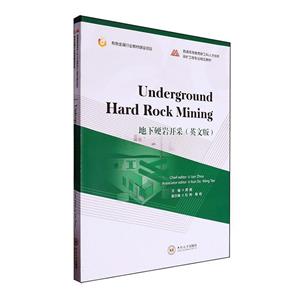扫一扫
关注中图网
官方微博
本类五星书更多>
-
>
湖南省志(1978-2002)?铁路志
-
>
公路车宝典(ZINN的公路车维修与保养秘籍)
-
>
晶体管电路设计(下)
-
>
基于个性化设计策略的智能交通系统关键技术
-
>
德国克虏伯与晚清火:贸易与仿制模式下的技术转移
-
>
花样百出:贵州少数民族图案填色
-
>
识木:全球220种木材图鉴
地下硬岩开采(英文版) 版权信息
- ISBN:9787548758235
- 条形码:9787548758235 ; 978-7-5487-5823-5
- 装帧:一般胶版纸
- 册数:暂无
- 重量:暂无
- 所属分类:>
地下硬岩开采(英文版) 内容简介
本书总结了国内近年来地下采矿新方法实践效果良好的方法,尤其是融入了中南大学及国内知名矿山近30年金属矿山成功开采理论、技术与经验。
地下硬岩开采(英文版) 目录
Chapter 1 Underground Mine Development and Mining Method
1.1 Underground mine development
1.2 Underground mining method
1.2.1 Open stope method
1.2.2 Backfilling method
1.2.3 Caving method
References
Chapter 2 Underground Mining Method Selection
2.1 Introduction
2.2 Essential criteria for mining method selection
2.3 Factors influencing the decision
2.3.1 Geology of the deposit
2.3.2 Economic considerations
2.3.3 Technological factors
2.3.4 Safety, health, environmental concerns
2.3.5 Political and social conditions
2.4 Underground mining method selection and evaluation methods
2.4.1 Qualitative methods
2.4.2 Numerical scoring methods
2.4.3 Decision-making models
2.5 Conclusions
References
Chapter 3 Empirical Methods in Mining Geomechanics
3.1 Introduction
3.2 Rock mass evaluation systems
3.2.1 Rock mass rating system (RMR)
3.2.2 Q-system
3.2.3 Rock mass index (RMi)
3.2.4 Geological strength index (GSI)
3.3 Open stope stability graph
3.3.1 Main ideas
3.3.2 Limitations
3.4 Excavatability classification systems
3.5 Blastability assessment systems
3.5.1 Blastability assessment factors
3.5.2 Blastability assessment indexes
3.6 Rockburst classification criteria
3.6.1 Single indicator criteria
3.6.2 Multi-index indicators criteria
3.6.3 Rockburst chart
3.7 Orepass design in hard rock mines
3.7.1 Orepass diameter
3.7.2 Orepass longevity
3.7.3 Orepass wall stability
3.8 Conclusions
References
Chapter 4 Design of Hard Rock Pillar in Underground Space
4. 1 Introduction
4.2 Design methods
4.2.1 Empirical method
4.2.2 Numerical simulation method
4.2.3 Statistical assessment method
4.2.4 Artificial intelligence method
4.3 Hard rock pillar design by examples
4.3.1 Example 1
4.3.2 Example 2
4.3.3 Example 3
4.3.4 Example 4
4.3.5 Example 5
4.3.6 Example 6
4.3.7 Example 7
4.3.8 Example 8
4.4 Conclusions
References
Chapter 5 Criteria for Underground Mine Damage
5.1 Introduction
5.1.1 Damage-failure in underground excavations
5.1.2 Overview of the main types of damage criteria
5.2 Failure criteria for underground mines in numerical analysis
5.2.1 Stress-based failure criteria
5.2.2 Strain-based failure criteria
5.3 Vibration energy as damage criteria
5.4 Peak Particle Velocity (PPV) criteria and damage assessment
5.4.1 Peak Particle Velocity (PPV) criteria
5.4.2 Peak particle velocity and frequency as damage criteria
References
Chapter 6 Drilling and Blasting in Hard Rock
6.1 Introduction
6.2 Rock drills classification
6.2.1 Mounting type
6.2.2 Motive power of rock drills
6.2.3 Mechanics of rock penetration efficiency
6.3 Blasting design
6.3.1 Blasting design process
6.3.2 Methodology
6.4 Blast damage criteria
6.5 Suggested damage threshold levels for rock damage
6.6 Underground mine blasting design
6.6.1 Tunnel blasting
6.6.2 Shaft sinking
6.6.3 Production ring blasts
6.6.4 Underground mining large-diameter long hole blasting
References
Chapter 7 Rockburst Prediction and Prevention in Underground Excavation
7.1 Introduction
7.2 Rockburst statistical analysis
7.2.1 Disaster statistics analysis
7.2.2 Rockburst characteristics analysis
7.3 Rockburst prediction
7.3.1 Empirical criteria method
7.3.2 Simulation technology
7.3.3 Mathematical modeling method
7.3.4 Microseismic monitoring technology
7.3.5 Comments for different forecasting methods
7.4 Rockburst prevention
7.4.1 Rockburst support design principles and control strategies
7.4.2 Rockburst support methods
7.5 Conclusions
References
Chapter 8 Backfill Technology and
展开全部
书友推荐
- >
伯纳黛特,你要去哪(2021新版)
伯纳黛特,你要去哪(2021新版)
¥18.4¥49.8 - >
李白与唐代文化
李白与唐代文化
¥11.3¥29.8 - >
【精装绘本】画给孩子的中国神话
【精装绘本】画给孩子的中国神话
¥17.6¥55.0 - >
莉莉和章鱼
莉莉和章鱼
¥16.4¥42.0 - >
回忆爱玛侬
回忆爱玛侬
¥23.0¥32.8 - >
罗曼·罗兰读书随笔-精装
罗曼·罗兰读书随笔-精装
¥20.3¥58.0 - >
我从未如此眷恋人间
我从未如此眷恋人间
¥32.4¥49.8 - >
史学评论
史学评论
¥23.5¥42.0
本类畅销
-
油田化学(富媒体)
¥38.5¥50 -
煤矿企业主要负责人考试手册:2018
¥30.2¥68 -
燃烧学
¥20.2¥48 -
地面生产保障、其他管理及后勤服务作业安全培训教材(煤矿从业人员培训教材)
¥23.6¥30 -
煤矿岗位作业流程标准化示范
¥50¥68
浏览历史
乡村振兴:实践探索与经验分享
¥69.4¥102.0



















